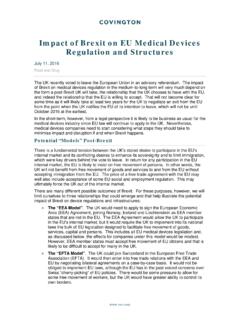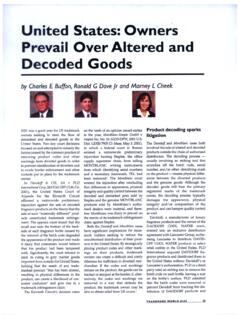Transcription of CMS Publishes Final Rule Regarding Medicaid Drug Rebate ...
1 CMS Publishes Final Rule Regarding Medicaid drug Rebate Program February 1, 2016. Health Care Today, the Centers for Medicare & Medicaid Services (CMS) published in the Federal Register the long-awaited Covered Outpatient Drugs Final Rule. 81 Fed. Reg. 5170 (Feb. 1, 2016). The rule implements changes to the Medicaid drug Rebate Program (MDRP) that were enacted by the Affordable Care Act (ACA) and addresses other key MDRP issues. With some exceptions, the rule will be applied prospectively effective April 1, 2016. The rule was finalized four years after it was proposed. It was the subject of much comment and controversy. The Final Rule may have significant economic impact for drug manufacturers, both in terms of rebates payable and systems changes required to implement the rule. This alert presents a summary of a lengthy and complicated rule. It is intended to give readers an overview of the most important areas covered by the rule but does not discuss many of the ambiguities and nuances of the Final Rule.
2 We would be pleased to discuss with you in more detail any aspect of the Final Rule. Table of Contents Brief Summary of Key Provisions ..2. Calculation of Standard AMP ..2. Calculation of AMP for 5i Drugs ..5. Smoothing Methodology for Standard and 5i AMP ..7. AMP Reporting Issues ..8. Determination of Best Other Provisions Related to AMP and Best Price ..11. Line Covered Outpatient Drugs: Definition and Categories ..14. Sales in Territories ..15. rebates to Medicaid Managed Care Organizations ..15. Use of Actual Acquisition Cost by Health Care Brief Summary of Key Provisions The Final Rule: Defines Average Manufacturer Price (AMP) as proposed, but allows for the continued use of a presumed inclusion methodology rather than mandating the buildup approach. Provides additional detail about the identification of so-called 5i drugs and the methodology for calculating AMP for these drugs.
3 Permits restatement of base date AMP to reflect the requirements of the Final Rule until April 1, 2017. Revises the definition of a manufacturer's best price and aligns it with the new AMP. definition. Excludes from best price all sales to 340B covered entities, regardless of whether sales are made at the 340B price. Finalizes a four-part test for bona fide service fees (BFSFs) excludable from AMP and best price, but abandons the proposal to limit such fees to those paid only to wholesalers and retail community pharmacies (RCPs). Seeks comments on line extensions; finalizes two proposed provisions related to line extensions but delays finalizing the line extension definition. Revises the definition of states and United States to include the territories, meaning that sales in the territories will be included in the MDRP both for purposes of price reporting and payment of rebates , effective April 1, 2017.
4 Finalizes the extension of rebates to Medicaid managed care organizations (MCOs). Sets Actual Acquisition Cost (AAC) as the basis for state Medicaid reimbursements based on ingredient cost. Calculation of Standard AMP. The rule finalizes the definition of AMP as proposed. The AMP of a covered outpatient drug (COD) will be defined as the average price paid to the manufacturer for the drug in the United States by wholesalers for drugs distributed to retail community pharmacies and retail community pharmacies that purchase drugs directly from the manufacturer. 42 Sales Included in Calculation of AMP. We address the sales included in the calculation of AMP below, highlighting any significant changes from the proposed rule. Sales to Retail Community Pharmacies CMS finalized the definition of an RCP as an independent pharmacy, a chain pharmacy, a supermarket pharmacy, or a mass merchandiser pharmacy that is licensed as a pharmacy by the State and that dispenses medications to the general public at retail prices.
5 42 The definition excludes a pharmacy that dispenses prescription medications primarily through the mail, nursing home pharmacies, long-term care facility pharmacies, 2. Health Care hospital pharmacies, clinics, charitable or not-for-profit pharmacies, government pharmacies, or pharmacy benefit managers. 42 CMS clarified in the Final Rule that sales to home health care, home infusion, and specialty pharmacies may be included in the AMP calculation only to the extent they otherwise meet the definition of an RCP; , such an entity that dispenses primarily through mail would not meet the definition of an RCP. CMS also clarified that sales by an RCP with an additional home delivery service to send prescriptions directly to a patient's home would be included in AMP, as long as the pharmacy does not offer prescriptions primarily through the mail. If, however, a single entity owns both an RCP and a mail order pharmacy where medication is dispensed primarily through the mail, manufacturers may exclude the sales to the mail order pharmacy when determining AMP.
6 Sales to RCPs include any sales, payments, or other financial transactions that are received by, paid by, or passed through retail community pharmacies. 42 (b)(3). CMS. clarified in the Final Rule that manufacturers with evidence or knowledge of a discount, Rebate , payment, or other financial transaction being passed through to an RCP must account for these transactions in calculating AMP. Absent this evidence or knowledge, manufacturers may continue to make reasonable assumptions about whether discounts are passed through to RCPs. Sales to Wholesalers The definition of wholesaler was finalized as proposed, as a drug wholesaler that is engaged in wholesale distribution of prescription drugs to retail community pharmacies, including but not limited to manufacturers, repackers, distributors, own-label distributors, private-label distributors, jobbers, brokers, warehouses (including manufacturer's and distributor's warehouses, chain drug warehouses, and wholesale drug warehouses), independent wholesale drug traders, and retail community pharmacies that conduct wholesale distributions.
7 CMS clarified that the rule does not impose any requirements on wholesalers to report sales made to RCPs; rather, it is the manufacturer's responsibility to calculate and report AMP to CMS. To calculate AMP, manufacturers may continue to use the presumed inclusion approach where they may presume, in the absence of adequate documentation to the contrary, that certain prices paid to manufacturers by wholesalers are for drugs distributed to RCPs, without data concerning that actual distribution. The Final Rule abandons a proposal that manufacturers implement the buildup methodology approach, under which a manufacturer would have been able to include in AMP calculations only those prices where there was adequate, verifiable documentation showing that the drug was actually distributed to an RCP, either directly or indirectly through a wholesaler. In the Final Rule, CMS acknowledged that the buildup approach was less practical and would require a significant change from the methodology manufacturers have traditionally used to calculate AMP, and that the better alternative for calculating AMP is the presumed inclusion approach.
8 Other Sales Included in the Determination of AMP. In the Final Rule, CMS also identified specific sales, nominal price sales, and associated discounts, rebates , payments or other financial transactions that manufacturers should include in the determination of AMP. 42 (b). CMS added the term associated in the regulatory language to clarify that it is the sales themselves, as well as the discounts, rebates , 3. Health Care payment or financial transactions associated with the sales that are included in the AMP. calculation, unless otherwise specifically excluded.. CMS's proposal to include in the calculation of AMP sales to other manufacturers who act as wholesalers for drugs distributed to RCP was finalized as proposed. Transactions Excluded from the Calculation of AMP. We address the transactions excluded from the calculation of AMP below, highlighting any significant changes from the proposed rule.
9 Bona Fide Service Fees As discussed in more detail below, the Final Rule excludes from AMP any bona fide service fees that meet a four-part regulatory test. Returned Goods Excluded from AMP are reimbursements by manufacturers for recalled, damaged, expired, or otherwise unsalable returned goods, including (but not limited to) reimbursement for the cost of the goods and any reimbursement of costs associated with return goods handling and processing, reverse logistics, and drug destruction only to the extent that such payment covers only those costs. 42 (c)(16). CMS left the terms recalled, damaged, . expired, and unsalable undefined, stating that these terms are self-explanatory. CMS. clarified that when a manufacturer faces difficulty in determining the purchase price of returned goods, it may rely on company records and reasonable assumptions to establish the value of the goods to be excluded from AMP.
10 Notably, CMS removed the good faith requirement for the exclusion of returned goods set forth in its 2007 rule implementing the Deficit Reduction Act of 2005. Instead the agency stated that a good faith requirement was unnecessary, as returns designed to adjust prices or disguise price concessions would not be made in good faith since the reimbursement would cover more than the allowable costs. Medicare Coverage Gap Discount CMS finalized its proposal to exclude from AMP any discounts, rebates , or other price concessions provided under the Medicare coverage gap discount program. This is consistent with the statutory provision requiring that discounts provided by manufacturers under the Coverage Gap Discount program be excluded. PBM Price Concessions The exclusion of pharmaceutical benefit manufacturers (PBMs) from the definition of an RCP is finalized as proposed. 42 (a).









